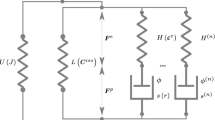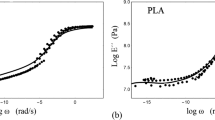Abstract
An enhanced rheological network is presented for the material modeling of thermoviscoplasticity. By introducing new basic elements, nonlinear isotropic and kinematic hardening may be depicted as well as an improved description of energy storage and dissipation during plastic deformations. Satisfying the thermomechanical consistency, the yield function and the flow rule are directly deduced from the stress equilibrium and the kinematics of the rheological network by means of simple algebraic calculations. Novel approaches are proposed to account for a process-dependent energy storage also for the case of ideal plasticity. The resulting energy storage behavior is investigated and validated by means of the simulation of tension test data.
Similar content being viewed by others
References
Altenbach J., Altenbach H.: Einführung in die Kontinuumsmechanik. Teubner, Stuttgart (1994)
Armstrong, P.J., Frederick, C.O.: A Mathematical Representation of the Multiaxial Bauschinger Effect. General Electricity Generating Board, Report No. RD/B/N731 (1966)
Bever M.B., Holt D.L., Titchener A.L.: The Stored Energy of Cold Work. Pergamon Press, Oxford (1973)
Bröcker C., Matzenmiller A.: Thermoviscoplasticity deduced from enhanced rheological models. PAMM 12, 1–2 (2012)
Chaboche J.L.: Cyclic viscoplastic constitutive equations, part I: a thermodynamically consistent formulation. J. Appl. Mech. 60, 813–821 (1993)
Chaboche J.L.: Cyclic viscoplastic constitutive equations, part II: stored energy—comparison between models and experiments. J. Appl. Mech. 60, 822–828 (1993)
Chrysochoos A., Maisonneuve O., Martin G., Caumon H., Chezeaux J.C.: Plastic and dissipated work and stored energy. Nucl. Eng. Des. 114, 323–333 (1989)
Findley W.N., Lai J.S., Onaran K.: Creep and Relaxation of Nonlinear Viscoelastic Materials. Dover Publication, New York (1989)
Giesekus H.: Phänomenologische Rheologie. Springer, Berlin (1994)
Haupt P.: Continuum Mechanics and Theory of Materials. Springer, Berlin (2002)
Haupt, P.: Theory of materials: summarizing remarks. In: Bruhns, O.T., Meyers, A. (eds.) Proceedings of 9th International Symposium on Plasticity and Impact Mechanics. The University Press Bochum (2007)
Haupt P., Helm D., Tsakmakis C.: Stored energy and dissipation in thermoviscoplasticity. ZAMM 77, S119–S120 (1997)
Helm, D.: Experimentelle Untersuchung und phänomenologische Modellierung thermomechanischer Kopplungseffekte in der Metallplastizität. In: Hartmann, S., Tsakmakis, C. (eds.) Aspekte der Kontinuumsmechanik und Materialtheorie. Report 1/1998 of the Institute of Mechanics, University of Kassel, Moenchebergstr. 7, Kassel (1998)
Helm D.: Stress computation in finite thermoviscoplasticity. Int. J. Plast. 22, 1699–1727 (2006)
Jansohn, W.: Formulierung und Integration von Stoffgesetzen zur Beschreibung großer Deformationen in der Thermoplastizität und -viskoplastizität. Doctoral Thesis, Scientific reports FZKA–6002, Institute for Materials Research, Research Center Karlsruhe, Kaiserstr. 12, Karlsruhe (1997)
Kamlah, M.: Zur Modellierung des Verfestigungsverhaltens von Materialien mit statischer Hysterese im Rahmen der phänomenologischen Thermomechanik. Doctoral Thesis, Report 3/1994 of the Institute of Mechanics, University of Kassel, Moenchebergstr. 7, Kassel (1994)
Kamlah M., Haupt P.: On the macroscopic description of stored energy and self heating during plastic deformation. Int. J. Plast. 13, 893–911 (1998)
Kletschkowski T., Schomburg U., Bertram A.: Viskoplastische Materialmodellierung am Beispiel des Dichtungswerkstoffs Polytetrafluorethylen. Technische Mechanik 21, 227–241 (2001)
Krawietz A.: Materialtheorie. Springer, Berlin (1986)
Krempl E., McMahon J.J., Yao D.: Viscoplasticity based on overstress with a differential growth law for the equilibrium stress. Mech. Mater. 5, 35–48 (1986)
Lemaitre J., Chaboche J.L.: Mechanics of Solid Materials. Cambridge University Press, Cambridge (1990)
Lion A.: A physically based method to represent the thermo-mechanical behaviour of elastomers. Acta Mech. 123, 1–25 (1997)
Lion A.: Constitutive modelling in finite thermoviscoplasticity: a physical approach based on nonlinear rheological models. Int. J. Plast. 16, 469–494 (2000a)
Lion, A.: Thermomechanik von Elastomeren: Experimente und Materialtheorie. Habilitation Thesis, Report 1/2000 of the Institute of Mechanics, University of Kassel, Moenchebergstr. 7, Kassel. http://nbn-resolving.de/urn:nbn:de:hebis:34-2007092619247 (2000b)
Lion, A., Sedlan, K.: Finite Thermoviskoplastizität: Eine Methode zur Formulierung thermodynamisch konsistenter Stoffgleichungen. In: Hartmann, S., Tsakmakis, C. (eds.) Aspekte der Kontinuumsmechanik und Materialtheorie. Report 1/1998 of the Institute of Mechanics, University of Kassel, Moenchebergstr. 7, Kassel (1998)
Maugin G.A.: The Thermomechanics of Plasticity and Fracture. Cambridge University Press, Cambrigde (1992)
Meinhard, H.: Rheologische Untersuchungen zu Härteeindruckexperimenten im Nanometerbereich. Doctoral Thesis, Institute of Physics, Martin-Luther-University Halle-Wittenberg, Betty-Heimann-Str. 7, Halle. http://nbn-resolving.de/urn/resolver.pl?urn=urn:nbn:de:gbv:3-000000239 (1999)
Oliferuk W., Gadaj S.P., Grabski M.W.: Energy storage during the tensile deformation of armco iron and austenitic steel. Mater. Sci. Eng. 70, 131–141 (1985)
Oliferuk W., Maj M., Raniecki B.: Experimental analysis of energy storage rate components during tensile deformation of polycrystals. Mater. Sci. Eng. A 374, 77–81 (2004)
Perżyna P.: The constitutive equations for rate sensitive plastic materials. Q. Appl. Math. 20, 321–332 (1963)
Reiner M.: Rheologie in elementarer Darstellung. Carl Hanser Verlag, München (1969)
Rieger, S.: Temperaturabhängige Beschreibung visko-elasto-plastischer Deformationen kurzglasfaserverstärkter Thermoplaste. Modellbildung, Numerik und Experimente. Doctoral Thesis, Institute of Applied Mechanics (Civil Engineering), University Stuttgart, Pfaffenwaldring 7, Stuttgart. http://nbn-resolving.de/urn:nbn:de:bsz:93-opus-19462 (2004)
Shutov A., Panhans S., Kreißig R.: A phenomenological model of finite strain viscoplasticity with distortional hardening. J. Appl. Math. Mech. 91(8), 653–680 (2011)
Shutov A.V., Ihlemann J.: On the simulation of plastic forming under consideration of thermal effects. Materialwissenschaft und Werkstofftechnik 42, 632–638 (2011)
Simo J., Miehe C.: Associative coupled thermoplasticity at finite strains: formulation, numerical analysis and implementation. Comput. Methods Appl. Mech. Eng. 98(1), 41–104 (1992)
Simo J.C., Hughes T.J.R.: Computational Inelasticity. Springer, New York (1998)
Taylor G.I., Quinney H.: The latent energy remaining in a metal after cold working. Proc. R. Soc. Lond. Ser. A Math. Phys. Sci. 143, 307–326 (1934)
Tsakmakis, C.: Methoden zur Darstellung inelastischen Materialverhaltens bei kleinen Deformationen. Habilitation Thesis, Report 5/1994 of the Institute of Mechanics, University of Kassel, Moenchebergstr. 7, Kassel. http://nbn-resolving.de/urn:nbn:de:hebis:34-2007102419481 (1994)
Tschoegl N.W.: The Phenomenological Theory of Linear Viscoelastic Behavior. Springer, Berlin (1989)
Valanis K.C.: A theory of viscoplasticity without a yield surface: part I, general theory. Arch. Mech. 23, 517–533 (1971)
Visintin A.: Mathematical models of hysteresis. In: Bertotti, G., Mayergoyz, I.D. (eds.) The Science of Hysteresis, vol. 1, Elsevier, Amsterdam (2006)
Wriggers P.: Nichtlineare Finite-Element-Methoden. Springer, Berlin (2001)
Ziegler H.: An Introduction to Thermomechanics. North-Holland, Amsterdam (1977)
Author information
Authors and Affiliations
Corresponding author
Additional information
Communicated by Andreas Öchsner.
Rights and permissions
About this article
Cite this article
Bröcker, C., Matzenmiller, A. An enhanced concept of rheological models to represent nonlinear thermoviscoplasticity and its energy storage behavior. Continuum Mech. Thermodyn. 25, 749–778 (2013). https://doi.org/10.1007/s00161-012-0268-3
Received:
Accepted:
Published:
Issue Date:
DOI: https://doi.org/10.1007/s00161-012-0268-3
Keywords
- Rheological models
- Thermoviscoplasticity
- Novel ideal bodies
- Representation of energy storage/dissipation




